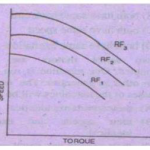Dc Motors Objectives Part 07
121 . Which test can be used for estimating no load losses in large dc shunt motor? Swinburne test.
122 . Which losses can be determined by performing the retardation test? Stray losses.
123 . The function for a starter for a dc motor is to limit the starting current.
124 . If the speed of a shunt motor is to be controlled b/w zero and normal running speed N, the most practical way to achieve this would be to inserting a resistance of suitable value in series with armature.
125 . During the normal operation of series motor, if the field circuit suddenly opens the motor speed will decrease.
126 . The direction of rotation of a compound dc motor can be effectively reversed by interchanging armature connections.
127 . A dc motor can be easily identified by commuator.
128 . In a compound dc motor, the shunt field winding as compared to series field winding will have more turns and a smaller cross-section of wire
129 . A large shunt motor should be started preferably using a compensator.
130 . The factor connected to a dc motor are: a) armature current (b)flux per pole (c)speed
The torque developed by a dc motor is dependent upon (a) and (b)
131 . Connections for dc compound motors are shown in figure below. Which figure shows the connections for differentially compound motor?

132 . Which of the following loss of motor decreases with increase in load (a)core loss (b)friction and windage loss (C)brush contact loss (d) none of above
133 . A 230V series motor in which the total field and armature resistance is 0.1ohm is working with unsaturated field, taking 100A and running at 800rpm. The speed at which the motor will run developing half the torque, is 1147rpm.
134 . The amount of flux leakage will depend on the flux density employed in core and teeth, length of airgap and shape of magnetic core
135 . The usual value of flux leakage co-efficient is 1.1 to 1.3.
137 . The direction of rotation of cumulatively compound dc motor can be reversed by reversing the connections to the armature.
137 . In which of the following test only one motor is required? Brake test.


